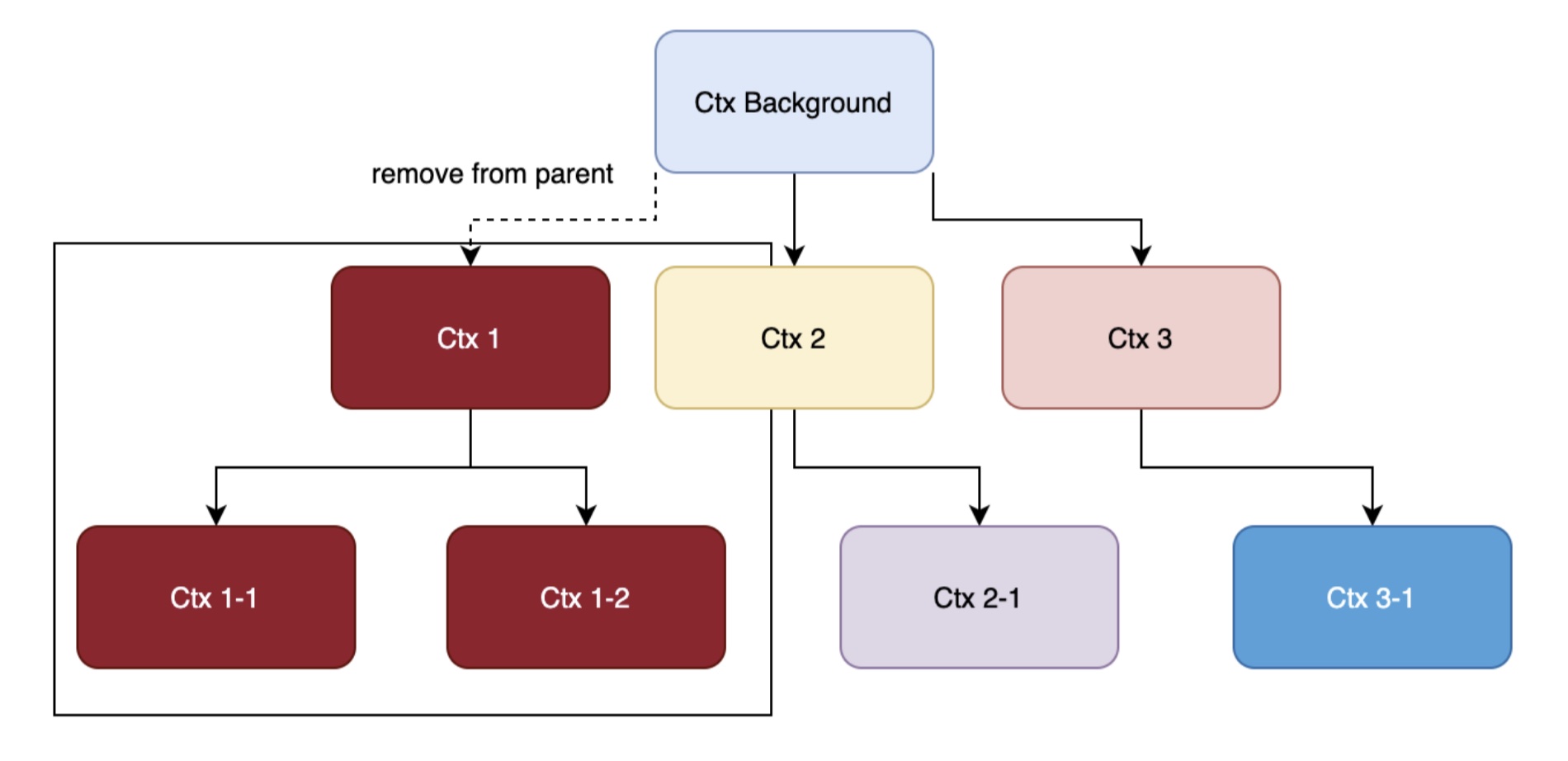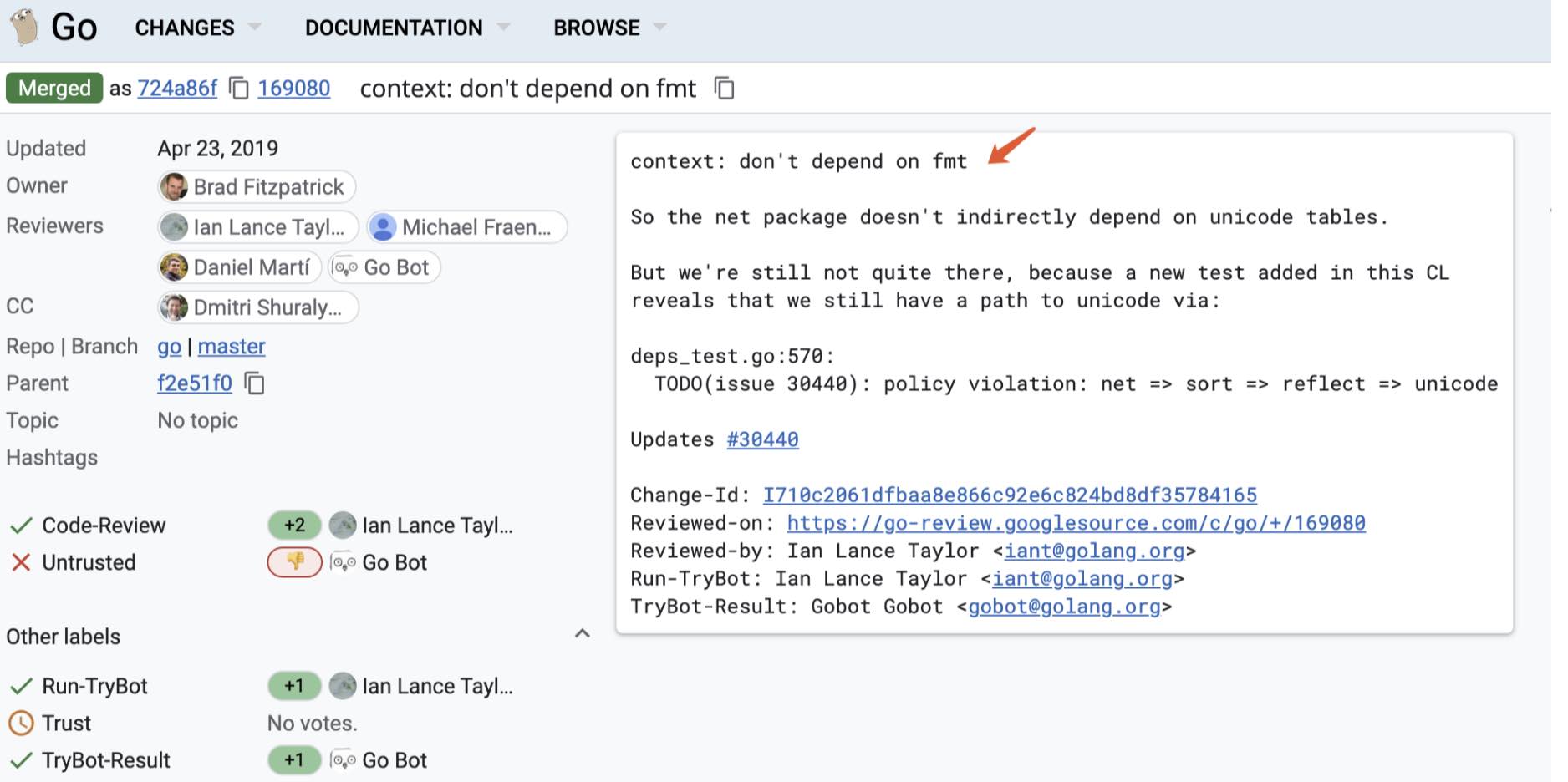Go Context 最佳实践

去年写了也许是 Context 最佳实践, 回头看有些遗漏,重新编辑整理,总结截至 go 1.17 的最佳实践
尽管有人说Context should go away in GO2, 但是现有的代码中还是大量使用 Context, 并不是每个人都了解 Context, 从去年到现在就见过两次因为错误使用导致的问题。每个同学都会踩到坑,今天分享下 Context 库使用的 Dos and Don’ts
使用场景
Context 主要有以下三种使用场景
- 传递超时信息,这点用的最多
- 传递信号,用于消息通知,处理多协程通信
- 传递数据,常用的框架层 trace-id, metadata
举一个 etcd watch 的例子,我们加深了解
1 | func watch(ctx context.Context, revision int64) { |
首先基于参数传进来的 parent ctx 生成了 child ctx 与 cancel 函数。然后 Watch 时传入 child ctx, 如果此时 parent ctx 被外层 cancel, child ctx 也会被级联 cancel, rch 会被 etcd 关闭,然后 for 循环走到 select 逻辑,此时 child ctx 被取消了,所以 <-ctx.Done() 生效,watch 函数返回
其于 context 可以很好的做到多个 goroutine 协作,超时管理,大大简化了开发工作。这也是 Go 的魅力
原理
1 | type Context interface { |
Context 是一个接口
Deadlinectx 如果在某个时间点关闭的话,返回该值。否则 ok 为 falseDone返回一个 channel, 如果超时或是取消就会被关闭,实现消息通讯Err如果当前 ctx 超时或被取消了,那么 Err 返回错误Value根据某个 key 返回对应的 value, 功能类似字典
目前的实现有 emptyCtx, valueCtx, cancelCtx, timerCtx. 可以基于某个 Parent 派生成 Child Context
1 | func WithValue(parent Context, key, val interface{}) Context |

经过多次派生后,ctx 是一个类似多叉树的结构。当 ctx-1 被 cancel 时,会级联 cancel 以 ctx-1 为根的整棵树,但是原来的 root, ctx2 ctx3 不受影响
1 | func (c *cancelCtx) cancel(removeFromParent bool, err error) { |
首先检测 done channel, 如果有人监听,那么 close 掉,这时所有 wait 这个 ctx 的 goroutines 都会收到消息
然后遍历 children map, 依次 cancel 所有 child, 这里类似树的先序遍历。最后 removeFromParent 将自己从父节点中摘除
几个问题
打印 Ctx
以 WithCancel 为例子,可以看到 child 同时引用了 parent, 而 propagateCancel 函数的存在,parent 也会引用 child(当 parent 是 cancelCtx 类型时)
1 | func WithCancel(parent Context) (ctx Context, cancel CancelFunc) { |
如果此时打印 ctx, 就会递归调用 String() 方法,就会把 key/value 打印出来。如果此时 value 是非线程安全的,比如 map, 就会引发 concurrent read and write panic
这个案例就是 http 标准库的实现 server.go:2906 行代码,把 http server 保存到 ctx 中
1 | ctx := context.WithValue(baseCtx, ServerContextKey, srv) |
最后调用业务层代码时把 ctx 传给了用户
1 | go c.serve(connCtx) |
如果此时打印 ctx, 就会打印 http srv 结构体,这里面就有 map. 感兴趣的可以做个实验,拿 ab 压测很容易复现
1 | func stringify(v interface{}) string { |

同时注意,后来 go 对此做了部份修复,一定程序上解决了问题。但也记住不要打印 ctx
Key/Value 类型不安全
1 | // A valueCtx carries a key-value pair. It implements Value for that key and |
强烈不建义使用 Context 传递过多数据,这里可以看到 key/value 类型都是 interface{}, 编译期无法确定类型,运行期需要断言,有性能和安全问题
关闭底层连接
Context 超时会触发 http pool 关闭掉底层 connection, 导致连接频繁销重建,参考之前的文章超时控制一个反例
问题在于,要在哪层处理 tcp 无用数据,如果应用层读完再丢掉,此时连接还是可用的,但是操作系统 tcp stack 处理无用数据,那直接就 close. 而 grpc 就没这个问题,因为多路复用,每个请求都是虚拟的 stream, 如果超时,只需关闭 stream, 无需关闭底层 tcp 连接
双向链表
当 Context 派生层数比较多时,构成了一个双向链表,key/value 获取很有可能退化成 O(N) 操作,非常慢
1 | type valueCtx struct { |
每当添加一个 key/value 时都会生成新的 valueCtx, 查询时,如果当前 ctx 不存在 key, 则递归查询 c.Context
提前超时
1 | func test(){ |
当调用栈较深,多人合作时很容易产生这种情况。其实还是没明白 ctx cancel 工作原理,异步 go 出去的业务逻辑需要基于 context.Background() 再派生 child ctx, 否则就会提前超时返回
另外大家容易忽略的点,默认情况下 grpc 会透传超时时间的,比如入口 A 服务调 B, 超时设置了 2s, B 如果用同一个 Context 去调下游 C, 那么超时就要减去 B 自己处理的时间。如果链路比较长,很可能到达 G 服务时就己经超时了
传递超时可以提前释放资源,否则入口超时了,后端还在处理请求
自定义 Ctx
非常不建义自定义 Context, 原因在于源码中处理是不同的
1 | // propagateCancel arranges for child to be canceled when parent is. |
通过源码可知,parent 引用 child 有两种方式,官方 cancelCtx 类型的是用 map 保存。但是非官方的需要开启 goroutine 去监测。本来业务代码己经 goroutine 满天飞了,不加节制的使用只会增加系统负担
使用建议
最后来总结下 context 使用的几个原则:
- 除了框架层不要使用
WithValue携带业务数据,这个类型是interface{}``, 编译期无法确定,运行时assert` 有开销。如果真要携带也要用 thread-safe 的数据 - 一定不要打印
Context, 尤其是从http标准库派生出来的,谁知道里面存了什么 Context通常做为第一个参数传给函数,但如果Context生命周期等同于结构体,当成结构体成员也可以- 尽可能不要自定义用户层
Context, 除非收益巨大 - 异步 goroutine 逻辑使用
Context时要清楚谁还持有,会不会提前超时,尤其调 rpc, db, redis 时 - 派生出来的 child ctx 一定要配合 defer cancel() 使用,释放资源
小结
写文章不容易,如果对大家有所帮助和启发,请大家帮忙点击在看,点赞,分享 三连
关于 Context 大家有什么看法,欢迎留言一起讨论,大牛多留言 ^_^
